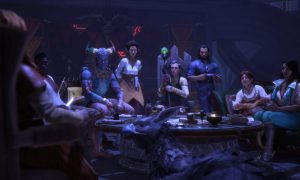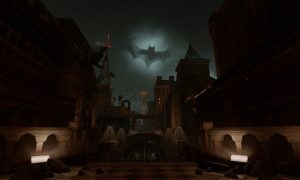All eyes are on the next-gen console launch. Almost every preview you’ll see this week is for the PS4 or Xbox One. Every event we have attended in the last few months have been next-gen related. What about those who are waiting to see how the launch of those platforms go and still want to experience the fantastic titles we’ve got coming our way this holiday season? Well, today I set sail for the seven seas with Assassin’s Creed IV: Black Flag on the PlayStation 3. Could this current gen version deliver on that same promise without all of the graphical bells and whistles of the new consoles?
The previous game received plenty of criticism for a few things that weren’t ironed out until much later (read: bugs), as well as one design choice that didn’t quite resonate with all players. The beginning was a bit of a slow burn with a big twist when you realized that you were not playing as an Assassin, but actually as one of the leaders of the Templar order. Not everyone enjoyed the more measured approach to the game’s introduction, lamenting the amount of time it took to get to gameplay as the Assassin Connor. Starting in the middle of combat with several ships, Assassin’s Creed IV throws you headlong into naval battle that ultimately ends as you barely escape with your life, your ship, scuttled. Hold onto your tricorn hat though – it doesn’t let up from there.

I called out just how awesome the naval combat was in Assassin’s Creed III, but decried that it was also very segmented from the main story. Served as more of a side mission, the time spent on water was certainly the highlight for most players, and thankfully Ubisoft recognized that as well. While there is certainly plenty of on-land action (including the fantastic multiplayer experience), much of the game takes place aboard the Jackdaw – your ship.
Before we get into that, let’s back up a bit. The setup for Assassin’s Creed IV Black Flag is that you are an Abstergo Entertainment employee. The Templar-backed sinister group has formed a family-friendly company that plans to mass-market the Animus, giving average people the chance to live an action packed adventure. You are part of the Sample 17 Project – the second release for Abstergo Entertainment, with the first being Assassin’s Creed: Liberation featuring protagonist Aveline de Grandpré. As a tester, you are responsible for extracting the memories from a DNA strand that includes the life of Edward Kenway (father to Haytham Kenway, grandfather to Connor and an ancestor of Desmond Miles) – one of the pirates responsible for the building of the real-world one-time pirate republic of Nassau. This pirate-ran town served as a nesting ground for some of the most dangerous, feared, and infamous pirates of all time. Men like Ben Hornigold, Edward Thatch (or Teach in some texts), aka Blackbeard, and Captain Kidd, just to name a few. Welcome to the Caribbean, and welcome to the Golden Age of Piracy.
Similar in structure to the previous games, you’ll have ‘slices’ of Kenway’s memories to experience, each with major objectives and sub-tasks. These sub-objectives are better paced and a little more reasonable this time around, making them challenging but not frustrating. The story is also far more compelling this time, giving us a protagonist with some brash likability in direct opposition to the continuously angry Connor. Kenway and his assortment of brigand friends deliver some laugh-out-loud moments throughout the story, and you can empathize with them in their desire to make Nassau a republic ruled by free men.

The First Civilization stuff takes a bit of a backseat in Kenway’s memories, but the “real world” outside of the Animus still has the Templars driving towards a more mystic goal. The game doesn’t club you over the head with it though – these portions are all but optional.
Beyond the main story there are also 100 challenges broken up into various play styles. These are things you’ll likely accomplish through the course of normal play such as synchronizing five viewpoints, but can also be as difficult as surviving ten shark attacks or solving all of the Mayan staelae puzzles. There are also 200 Animus fragments for you to find, manuscript pages, letters, song sheets, and more, though the treasure maps and their eventual rewards are your obvious goals. The great part is that, unlike Assassin’s Creed III, these are far less ‘checklist-driven’ objectives. In fact, you can skip them almost entirely and still drive the main story forward. Occasionally you may receive a warning like “You may wish to upgrade the Jackdaw before you continue” but Black Flag doesn’t restrict you in any way. Conversely, the issue with parts of the Homestead becoming locked as you progress through chapters in Assassin’s Creed III is a non-issue in IV – there is no gating of any kind other than your ability to survive in more hostile waters.
Synchronization was a major part of uncovering the map and discovering codex pages or treasure chests. This continues in Black Flag, but you also have an entire ocean to contend with. Your synchronization points in that case are the numerous forts that dot the Caribbean. These forts have anywhere between three and nine ship-repelling defense structures that can include cannons and even long-range mortars. Once you tear down those defenses you’ll have to assault the fort, kill off any enemy officers within, and then take out the fort commander. At this point a small section of the ocean will be revealed, showing harpooning areas, chests, and any other goodies previously hidden. Like ships, all forts have a rating assigned that equates to their power level so your spyglass can tell you if it’s a good idea to approach.

If you are getting the idea that the world of Assassin’s Creed IV Black Flag is huge, I’m sure I’m still understating it – it’s so much bigger than I could have expected. If you skipped all of the side content and really didn’t dig into the collectables, you are still looking at a game that’ll take you conservatively over 30 hours to complete. There is even what I’d call some “Ruby Weapons” in the game – Legendary ships that will require every sailing and combat skill you’ve honed over the entire game to defeat. Before you’ll stand a chance against them, you’ll need money. Lots of it.
Money has really never been all that useful in Assassin’s Creed. The upgrades have always felt somewhat arbitrary, and building out your hideout always seemed cosmetic. The upgrade system in Black Flag is a huge step up, and money becomes the lifeblood of the game. The Jackdaw is a hungry beast, requiring upgrades to her armaments, hull, cargo hold, and even the reinforcements on her whaling skiff. These cost tens of thousands of Reales (the currency at the time), and some even require you to search for plans for the most advanced upgrades. Similarly, you’ll eventually have a safe house to upgrade which is extremely expensive. Your own equipment is similarly priced. Coming from the Vita title Liberation, you can now pick up a blowpipe complete with sleep and berserk darts. Thankfully the darts are cheap to buy or craft because they are a fantastic crowd dispersal tool. Even cheap darts add up though – it’s time to take to the high seas for some pillage and plunder.
There are several plantations in the world waiting for you to drop in and raid them. During the preview with the game I was told that there are eight types, each with their own story. In practice I found that they were more window dressing for the same activity. You disable a warning bell or two, grab a key from an unlucky sap, and then raid the storage building. I was hoping for more story behind these, but other than the first one that introduces the concept they all felt the same.

Beyond finding chests of loot, raiding other ships and selling the hard-fought cargo spoils is the best way to rake in the cash. The naval combat shown in various trailers pales in comparison to actually playing it. Ubisoft has put incredible work into the dynamics of the water, so ensuring you aren’t firing into the side of a large swell, using the dynamic weather to your advantage, or riding a high wave to crash your ships prow into the broadside of a schooner never stops being satisfying.
Naval combat is simplicity itself. In my interview with Ashraf Ismael he likened it to ‘shooter controls’, and it is exactly as he described. If you want to fire the chase cannons or chain shot in the prow, simply point the camera there and pull the trigger. Turning the camera to the port or starboard will give a quick highlight to your cannons which you pull the left trigger to arc and aim, and then the right trigger to fire. Dropping fire barrels off the back of the ship is again as simple as pointing the camera at the aft and then tapping the trigger. You’ll need every bit of this hardware too – ships stop coming at you one at a time pretty quickly.
At some point in the game you’ll likely spot a ship with an R on her sails in your map view. This is the Royal Convoy. This ship carries 10,000 Reales in her belly and is often a Spanish or French Frigate with at least a gunship or a schooner (or both) flanking her. Temptation will lure you into range of these ships early, but three vollies of heavy shot ripping through your hull will remind you where you stand. When you do have enough upgrades and skills to take them down though, it’s a cheer-out-loud moment. In order to claim your bounty, you’ll have to board her.

Boarding can only occur when a ship has usually had its fore, main, and mizzenmast destroyed. With the ship crippled, you can move along side and throw grappling hooks to her rails to pull her close. At this point you’ll be given a list of objectives that can include taking out a certain number of enemy crew, tearing the flag down from the crow’s nest, blowing up their powder reserves, killing officers and captains, or any combination therein. Taking the ship gives you the choice of either scuttling her to repair the Jackdaw, turning her loose to lower your infamy level, or adding her to your fleet of ships. The Kenway’s Fleet option is a great chance to talk about the second screen experience.
Assassin’s Creed IV Black Flag is one of the best examples of the second screen experience and how the next generation of games will extend beyond the couch. On your iOS or Android tablet you can bring up the in-game map, set waypoints, and best of all use it as a treasure map display. How it extends beyond the game is via Kenway’s Fleet. As you capture ships and send them to your fleet you can use this application to send them on missions. Similar to the mode we saw introduced in Assassin’s Creed II: Brotherhood, you can send your ships out to on trade routes to earn money, cargo, treasure, and maps that integrate directly into the game when you play next. If you play with friends, you can earn bonuses for securing their trade routes. This means you can be sitting at a bus stop or a doctor’s office and still be managing your fleet’s activities. This mode is surprisingly fun and can give your couch-side quartermaster something to do while you explore the Caribbean. If you don’t have a tablet, don’t fret – you can access all of the map functions via the pause menu, and you can manage your fleet from your Captain’s Quarters. There is no denying the convenience of doing it from a tablet though – I highly recommend it, and it’s free, so why not?
The second-screen is not the only social element in Black Flag. There are rare events that, when discovered, are then broadcasted to your friends. These can a sighting of the treasure fleet, whaling locations, named ships, and more. These are timed, so it’s best to take advantage when those opportunities arise.

Harpooning and whaling were big parts of the economy and the culture of the time. Scrimshaw (bone carvings) and tattoos celebrating the practice persist even today. Taking a page out of Far Cry 3’s book, you’ll need various pelts to fashion Kenway’s upgrades. Hunting functions in much the same way as it does in the other Ubisoft title until you hit the water. In your skiff you’ll harpoon various whales and sharks for their skins and bones. The bigger the game, the more dangerous, so keep that in mind when you stick a humpback whale. If you have a softer heart and don’t want to spear or kill any animals, you can buy the skins from a vendor for a premium price.
Speaking of rare, not all of the world’s treasures exist where you can see them, and diving bells can unlock an entire world underneath the surface. Sharks, hidden treasure troves, sunken treasure, and underwater caves complete with currents lie under marked wrecks in the ocean. There are also plans for the top-tier upgrades sunken in these dive locations, making them more valuable in the end-game.
The paranoia-inducing multiplayer of Assassin’s Creed has been given a bit of a facelift. The addition of a full tutorial system breaks the barrier of entry for new players, while giving a view of the new modes like Wolfpack and Game Lab. Wolfpack is a horde-like game that has up to four players tackling random objectives over the course of 25 rounds. Each successful kill (or simultaneously-executed multi-kill) nets you points that extend your time to reach the next level. Game Lab is really where the game will shine the most, offering up nearly all of the game mechanics to a ‘build your own mode’ system. Highly rated player-created modes will bubble to the top and become an official offering. I was told by a developer that there are more than 100,000 permutations. The best mode I’ve seen flipped the script on the normally close range murderfest, instead giving pistols to the players. This means it is no longer possible to be overly discrete, tipping your hand to any other player who might have observed your action. If you thought the paranoia was bad before, try firing a gun and then wondering who might have seen or heard it.

It’s not all sunshine and rainbows, but it was nice to see a lot less bugs than before. There is a bit of texture tearing, and the framerate does dip below 30 fairly often. Thankfully both are not severe enough to impact gameplay. Additionally, I ran into a bug where I couldn’t skin an animal after shooting it, and one hilarious bug where Kenway’s lips froze open, leaving him with a disturbingly awesome skeleton grin while he talked. I can say that the game has been supremely stable without a single lockup or non-cosmetic issue. It’s nice to see Ubisoft put more of a heavy focus on stability and bug fixing while still building this game on multiple platforms.
Graphically there is a pretty stark difference between the current and next-gen versions of this title. Trees in the current generation version look like flat paper mache versions of themselves, becoming as thin as paper at the right angle. Vegetation doesn’t react when you crawl through it. Rain looks great, as does the water, but waterfalls just simply looks chunky – not a natural descriptor for a liquid. Hair on characters varies between good and mud-caked clump strands. We are running against the edge of what can be done with the common resource constraints of memory and processor limitations. That isn’t to say the game looks terrible – far from it – but don’t expect it to look like all of the magnificent screenshots that have hit the web.
In the end, in terms of both single and multiplayer, Assassin’s Creed IV Black Flag has everything from the previous games and so much more. The overall polish has improved, and there is more fun to be had in this iteration than any previous. It no longer feels like a forced checklist, instead offering players the freedom to partake, skip, or mix and match as much as they see fit. The naval combat remains challenging and exciting for the entirety of the game, and this drives the continued value beyond the already-expansive single player experience. The multiplayer is just icing on an already-filling and wonderful tasting cake.
Ron Burke is the Editor in Chief for Gaming Trend. Currently living in Fort Worth, Texas, Ron is an old-school gamer who enjoys CRPGs, action/adventure, platformers, music games, and has recently gotten into tabletop gaming.
Ron is also a fourth degree black belt, with a Master's rank in Matsumura Seito Shōrin-ryū, Moo Duk Kwan Tang Soo Do, Universal Tang Soo Do Alliance, and International Tang Soo Do Federation. He also holds ranks in several other styles in his search to be a well-rounded fighter.
Ron has been married to Gaming Trend Editor, Laura Burke, for 28 years. They have three dogs - Pazuzu (Irish Terrier), Atë, and Calliope (both Australian Kelpie/Pit Bull mixes), and an Axolotl named Dagon!

During any new console launch where you have games that bridge generations there is always a question whether or not the current-gen versions will be a messy shadow of its prettier sister. From what I’ve seen so far, the PlayStation 4 version is amazing to look at but don’t count out the current-gen versions. It’s not often sequels do this good a job of giving us what we want, but Ubisoft has done exactly that - this is easily the best Assassin’s Creed title yet!
PROS
- Solid progression system for Kenway and the Jackdaw
- Visually improved
- Far less bugs than AC III
- A solid story and protagonist
- Ridiculous amounts of content
CONS
- Framerate hovers around 25 with texture tearing
- Plantations all feel the same
- Still a few (cosmetic) bugs present
- Vegetation and waterfalls look sub-par
See below for our list of partners and affiliates:
























